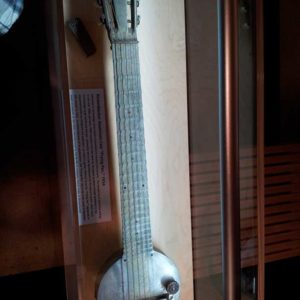The invention of the electric guitar is, in my opinion, the single greatest influence on modern music. I’m prepared to take some flak with that statement, I won’t dismiss anyone wanting to argue for the synthesizer.
But this site’s sole purpose is the appreciation of electric guitars, and a website like Rolling Stone should be a little embarrassed when they publish an article entitled “24 Inventions that Changed Music” and it not include any mention of the electric guitar. They must’ve forgotten that the Bob Dylan song that they lifted their magazine’s name from is actually famous for being Dylan’s first venture into music that featured an amplified electric band – he was booed terribly when he picked up an electric guitar on stage to play the song for the first time.
There doesn’t seem to be many of those stupid generic list posts that make any mention of the electric guitar. Anyway, back to the point – the electrified guitar is a modern invention and has shaped modern music immensely, pop or otherwise. In fact, I can’t think of many genres that haven’t taken advantage of the millions of sounds you can coax from it.
Early Guitar History
The guitar wasn’t always as diverse an instrument as it is now, and in its infancy, there was little resemblance. The first experiments involving amplifying stringed instruments began some time in the beginning of the 20th century – at least that’s about the time the first patents for inventions involving various transmitters and microphones that could be pulled out of a telephone.
These early attempts were being done on classical instruments rather than the guitar and the signals being transmitted were weak. The Stromberg Electro came out in 1928, and while it utilized electromagnetic pickups on a guitar, it was still an acoustic instrument that’d been electrified (not to mention, you had to plug it into a wall socket).
The first incarnation a proper electric guitar — a six-stringed solid-bodied instrument with wound pickups that utilized magnetic induction to detect changes in field flux from the string’s vibration — came in 1931. The Rickenbacker Electro A-22 was an electric lap-steel guitar, and while the manufacturer’s name makes Adolf Rickenbacker’s involvement apparent, a less well-known name was responsible for the original design; George Beauchamp.
The two had known each other from previously manufacturing some of the earliest examples of resonator guitars, of which Beauchamp’s company was responsible for while Rickenbacker’s handled the machine shop in charge of the manufacturing process. By 1932, the two were working together selling the A-22 under Rickenbacker’s name – which we’re all familiar with today.
Aptly nicknamed “Frying Pan”, this lap-steel guitar was designed with the intent to shun acoustic amplification properties – the original prototype featured a solid maple body and neck. By the time Rickenbacker got involved, the manufactured version was made of aluminum…body, neck, fretboard, bridge…virtually everything.
The pickups are notable for utilizing magnetic coils, and all pickups since have been based on this technology. It’s a design that is not unfamiliar to anyone who’s had an interest in lap-steel guitars, or has seen David Gilmour play live.
Obviously, the aluminum was ditched in exchange for all of the lovely hardwoods we have to choose from nowadays – but if you take a look at the design blueprint filed along with the patent application, we can see a lot of stuff that is common to us now, but entirely unique at the time.
I’ve always been partial to string-through bridge setups though, and if there are any proponents of body vibrational qualities having an effect on tone reading this, then the prospect of a bridge & body single cast along with a set-in neck may be a pretty cool combination. We are talking about a lap-steel though, long sustain is not really a worrisome selling point for these instruments.
The Glorified Frying Pan’s Legacy
One final note: if you look back at the patent application, you’ll note that it was filed in 1924 and awarded in 1927. This sluggish delay, courtesy of the US Patent and Trademark Office, allowed for various other guitar makers to put their contributions on the market, which allowed for the evolution of our beloved instrument to occur from multiple points with a competitive motivation driving the efforts.
All in all, the 1930s gave us Rickenbacker, Dobro, Gibson, and Epiphone – all of them still continuing to improve on and carry the legacy of Beauchamp’s original idea: to have an electric guitar that does away with acoustic properties, has a solid body and wound magnetic pickups, minimizes feedback, and can be heard loud and clear on any stage.
If you’d like to see an excellent custom Frying Pan style lap-steel with photographs of the build in process, take a look here.
Sources: Wikipedia, Vintage Guitar

